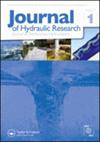Hydraulic resistance of artificial vegetation patches in aligned and staggered configurations
IF 1.7
3区 工程技术
Q3 ENGINEERING, CIVIL
引用次数: 1
Abstract
ABSTRACT The paper reports the results of laboratory experiments to investigate the effect of vegetation patch mosaics on hydraulic resistance. Experiments were run for seven levels of vegetation coverage with square patches of flexible plastic grass in aligned and staggered configurations and a wide range of hydraulic conditions. Hydraulic resistance was substantially higher for staggered than aligned configurations, particularly for intermediate ranges of vegetation coverage. The results indicate that hydraulic resistance differs between regimes of isolated roughness flow, wake interference flow, and skimming flow. Two types of models are proposed to predict hydraulic resistance (i.e. Manning’s coefficient n) for aligned and staggered configurations, one as a function of the nondimensional spatially-averaged hydraulic radius and another as a function of relative submergence and surface area blockage factor. To account for the effects of vegetation patch alignment, an additional factor α is introduced. This work provides comprehensive datasets and models that can be used to improve the prediction of hydraulic resistance in open-channel flows with vegetation patches.排列和交错配置人工植被斑块的水力阻力
摘要:本文报道了植被斑块镶嵌对水阻力影响的室内实验结果。实验在7个不同水平的植被覆盖下进行,包括排列和交错配置的方形柔性塑料草,以及各种水力条件。交错配置的水力阻力明显高于排列配置,特别是在植被覆盖的中间范围。结果表明,隔离粗糙流、尾迹干涉流和掠流的水力阻力不同。提出了两种模型来预测排列和交错构型的水力阻力(即曼宁系数n),一种是无因次空间平均水力半径的函数,另一种是相对淹没和表面积阻塞因子的函数。为了解释植被斑块排列的影响,引入了一个额外的因子α。这项工作提供了全面的数据集和模型,可用于改善有植被斑块的明渠水流的水力阻力预测。
本文章由计算机程序翻译,如有差异,请以英文原文为准。
求助全文
约1分钟内获得全文
求助全文
来源期刊

Journal of Hydraulic Research
工程技术-工程:土木
CiteScore
4.90
自引率
4.30%
发文量
55
审稿时长
6.6 months
期刊介绍:
The Journal of Hydraulic Research (JHR) is the flagship journal of the International Association for Hydro-Environment Engineering and Research (IAHR). It publishes research papers in theoretical, experimental and computational hydraulics and fluid mechanics, particularly relating to rivers, lakes, estuaries, coasts, constructed waterways, and some internal flows such as pipe flows. To reflect current tendencies in water research, outcomes of interdisciplinary hydro-environment studies with a strong fluid mechanical component are especially invited. Although the preference is given to the fundamental issues, the papers focusing on important unconventional or emerging applications of broad interest are also welcome.
 求助内容:
求助内容: 应助结果提醒方式:
应助结果提醒方式:


